IN THE LAND OF MILK AND HONEY is the second book in the Elizabeth Harris series, a series of murder mysteries set in Lancaster County, PA and involving the interplay of the Amish with the non-Amish Lancaster police. I’m thrilled to have it published under Berkeley Prime Crime.
IN THE LAND OF MILK AND HONEY by Jane Jensen
With its peaceful, hardworking Amish population, Lancaster County, Pennsylvania, is a rural paradise. But former NYPD homicide detective Elizabeth Harris knows that evil lurks there—it’s just easier to hide…
By solving the murders of two local girls, Elizabeth has gained some trust in the Amish community. So, she’s the first person its members turn to when a fast and fatal illness takes hold, though many believe that the sickness stems from a hexerei—a curse placed by a practitioner of old-world folk magic. Elizabeth doesn’t believe in curses, and when an entire Amish family is found dead, she begins to suspect something far more sinister…
As the CDC is called in to investigate, customers of a Philadelphia farmers market selling Amish raw milk start dying. Amid rapidly escalating panic, Elizabeth must peel away layers of superstition and fear to save the livelihood—and lives—of an entire community. Because what has happened isn’t an accident of nature or an act of God, it’s the handiwork of someone who has only just begun to kill…
Mystery | Amish [Berkley Prime Crime, On Sale: August 2, 2016, Trade Size / e-Book, ISBN: 9780425282908 / eISBN: 9780698407213]
Buy IN THE LAND OF MILK AND HONEY: Amazon.com | Kindle | BN.com | iTunes/iBooks | Kobo | Google Play | Powell’s Books | Books-A-Million | Indiebound | Amazon CA | Amazon UK | Amazon DE | Amazon FR
The story behind the book – RAW MILK POLITICS
The first book in the Elizabeth Harris mysteries, KINGDOM COME, has a small and intimate mystery. It’s claustrophobic in feel and involves the death of two young women, one Amish and one English, who are best friends. But with the second book in the series, IN THE LAND OF MILK AND HONEY, death threatens the entire community. The culprit is raw milk, which is, as Ezra says, more common than water on Amish farms. When entire Amish families come down with horrible flu-like symptoms and begin to die, the CDC comes in and traces the source of the food poisoning to raw milk from the family cows. But Detective Harris isn’t convinced the poisoning is from natural causes. Is there something more insidious at work here?
I was inspired to write this story by my own experiences with the raw milk movement. When my husband and I moved to Lancaster County six years ago, I was eager to do some homesteading on our twenty-acre farm. I’d been inspired by a number of homesteading books, especially Barbara Kingsolver’s ANIMAL, VEGETABLE, MIRACLE. The idea was to become more self-sufficient, grow or raise some of your own food, and reestablish a bond with the land, the natural cycle of life, and with farm animals.
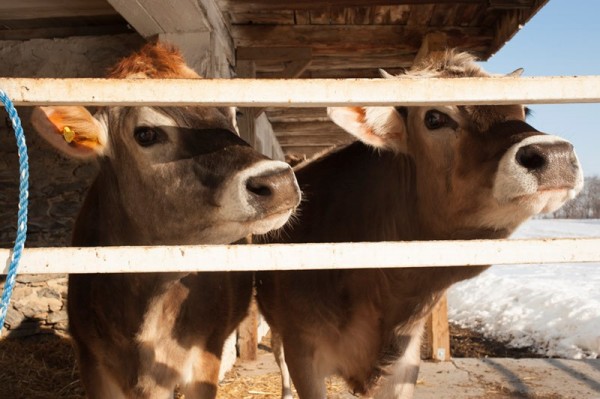
Above: Our cows Tinkerbell and Trueheart.
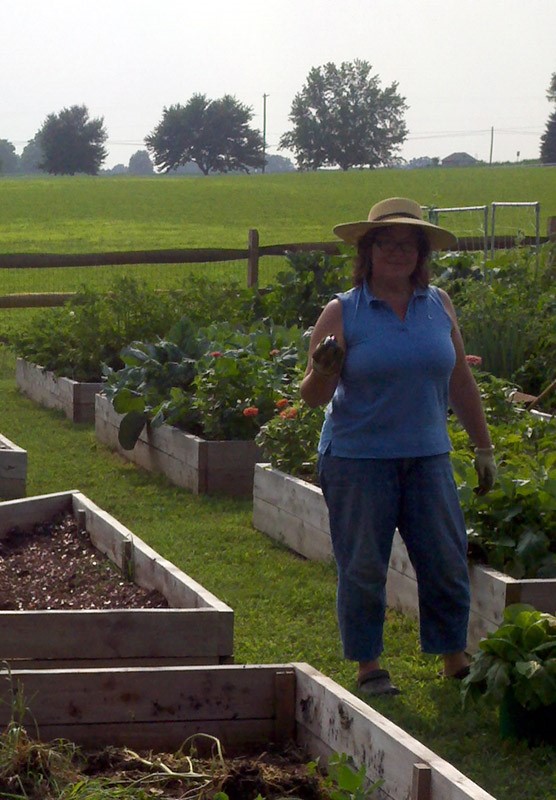
Above: The author in her garden.
Shortly after we bought our farm, we got two cows. One of them, Trueheart, was already pregnant when we got her. So after the calf was born, I set about learning how to milk a cow. I hadn’t been raised on a farm (my father was a minister), so this was definitely a new experience for me. But as an animal lover, I enjoyed getting to know the cows and being close to them.
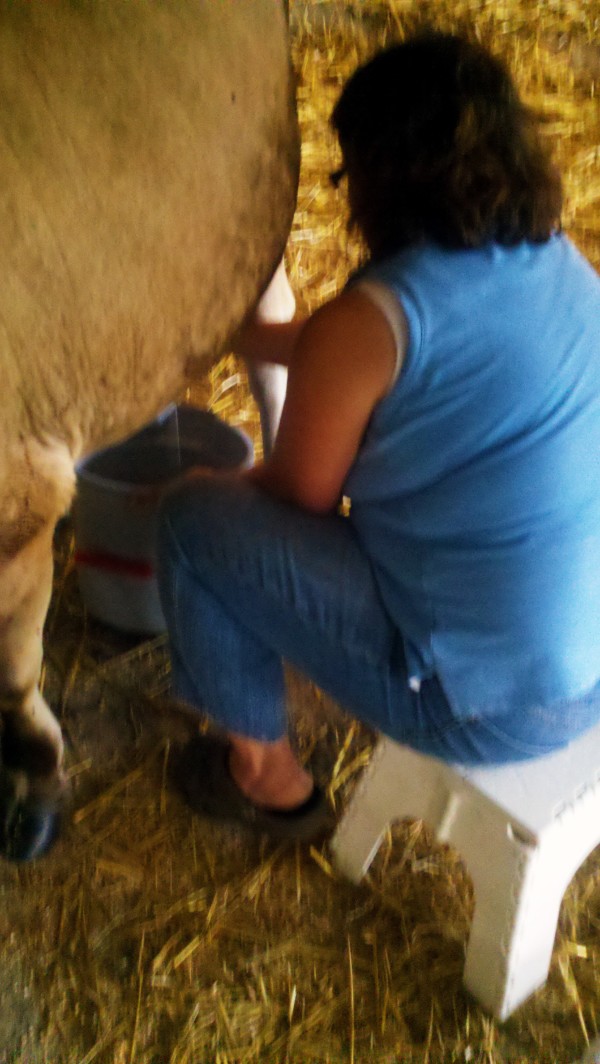
Above: The author milking Trueheart
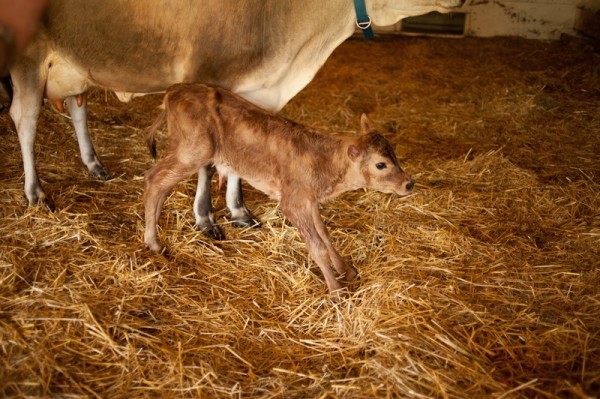
Above: Trueheart and her calf, Bessie, right after the birth
Besides the homesteading, I was also deeply into the ‘real foods’ or ‘natural foods’ movement, which advocates eating foods as close to their natural state as possible—unrefined and unprocessed. Part of this movement is the belief that it’s best to consume milk in its raw state, particularly when you can be sure the source is healthy and disease-free (which, having our own cows, we could do). So for several years I milked our cow and we drank the raw milk and we gave away the excess we couldn’t consume to friends.
As part of this milking experiment, I kept the calf with True during the day in the pasture and only separated the calf at night, so that I could milk True in the morning. But even milking just once a day, the amount of work and the volume produced was more than I felt was worth it for just my husband and myself. I eventually decided to stop milking our cow and let Bessie, the calf, stay with her mother all the time. As of this writing, five years later, we still have both mother and daughter and Bessie still nurses! She is indeed a very large and healthy Jersey heifer now. We have never bred either of them again and they are basically family pets.

Above: The author’s husband with True and Bessie in the pasture.
After I decided to stop milking True, we began to purchase raw milk from our Amish neighbors – it so much easier! My descriptions in the book about the on-farm milk stores come from our own experiences here in Lancaster County.
In those years in which we were drinkers of raw milk, I heard many arguments on both sides of the question. Did you know that selling raw milk is only legal in a few states? (Pennsylvania is one of them.) Those who disapprove of raw milk believe that pasteurization is the only way to safely consume milk products due to the possible presence of harmful bacteria in the raw product. On the other side, raw milk advocates claim that milk should be consumed as nature intended with all the ‘probiotics’ and living cultures still intact and not killed off by the heat of pasteurization. They claim that healthy cows in a clean environment won’t have bad bacteria in their milk and/or that the ‘good bacteria’ in milk will kill off any ‘bad bacteria’ that might be in it. This appears to be borne out in testing. Most states that allow raw milk sales do regular government inspection and testing of raw milk and do not find the presence of harmful pathogens.
But whatever the law says or doesn’t say on the matter, the fact is, most farming families drink a lot of milk and they drink it raw. My father, who grew up in the Great Depression, says his large family of a dozen siblings got a great deal of their daily calories from the raw milk from the family cow. Without this food they might have starved. And that’s the way it was for generations of farmers.
Being a mystery and thriller writer, what I saw underneath these political arguments, and underneath the seemingly bucolic trip to the local farm to pick up milk, was the possibility for something very sinister. I love sinister! J What if this gentle family member—the cow, and the beloved ubiquitous beverage of farmers and their children—milk, were to change from life-giving to poison overnight? And what if that were to crop up in random places throughout a community? How would you know who and what to trust then?
IN THE LAND OF MILK AND HONEY doesn’t attempt to answer the question of whether or not raw milk is good or bad. For Detective Elizabeth Harris, it’s all about the case, about solving the mystery and stopping the deaths. She’s frankly astonished at how passionately people on both sides of the question react in the story.
So why did I set a story around raw milk? I wanted to represent this culture I’d been a part of, the ‘real foods’ movement, in order to document and share my experiences and hopefully draw characters that are real, honest, and interesting. And, of course, I hope the setting and topic makes for a cracker of a mystery!
Ironically perhaps, my husband and I are now completely vegan. We no longer drink milk, raw or otherwise. I want to say it was part of our evolution with food—from seeking it in its most natural state and getting our hands dirty with gardening and raising farm animals, to realizing that we no longer wanted to be a part of causing any farm animals to suffer in any way. But I’ve been on all sides of the issues now, and I hope I can understand them. I tried to portray all the various characters in IN THE LAND OF MILK AND HONEY with respect and honesty.

Above: The newest addition to our farm family is this little pig, who wandered on to our land from God-knows-where and decided to stay.
I hope you enjoy “Kingdom Come” and IN THE LAND OF MILK AND HONEY. Please let me know by reviewing on Amazon or Goodreads or dropping me a note on facebook or in email [email protected]
All the best from Lancaster County,
Jane Jensen
About Jane Jensen
Jane Jensen is a novelist and game designer. Best known for her computer game series Gabriel Knight and her novel Dante’s Equation, she has published seventeen games and four thrillers. She also writes romance as Eli Easton.


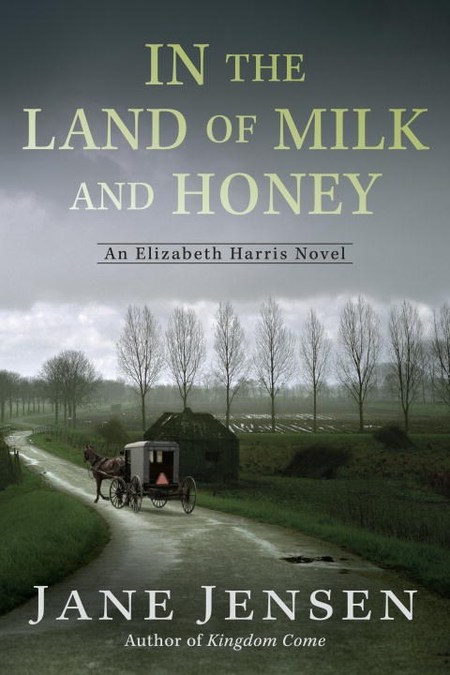
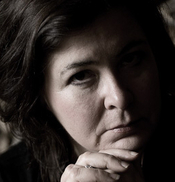
No Comments
Comments are closed.